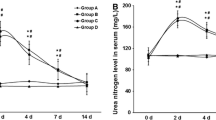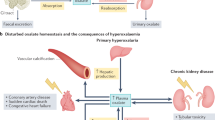Abstract
It is hypothesized that oxalate plays an active role in calcium oxalate (CaOx) nephrocalcinosis and oxalate driven nephrolithiasis by interacting with the kidney. We developed an adjustable, nonprecursor, continuous infusion model of hyperoxaluria and CaOx nephrocalcinosis to investigate this hypothesis. Minipumps containing PBS or KOx (60–360 μmol/day; n=5–7/dose) were implanted subcutaneously in male Sprague–Dawley rats on D0 and D6. Rats were killed on D13. Oxalate excretion and CaOx crystalluria were monitored by 20+4 h urine collections. Localization and content of intrarenal crystals were determined on frozen sections using polarization and μFTIR. Oxalate excretion was significantly elevated in all KOx rats (P≤0.005). CaOx crystalluria was most persistent in the 240–360 μmol/day KOx rats, but even 60 μmol/day KOx rats showed sporadic crystalluria. One hundred percent of KOx rats had CaOx nephrocalcinosis as confirmed by μFTIR. Most crystals were localized to the lumens of the corticomedullary collecting ducts. A few crystals are localized just under the papillar urothelium. The minipump model is the first model of hyperoxaluria to provide continuous infusion of oxalate. It permits control of the levels of hyperoxaluria, crystalluria and CaOx nephrocalcinosis. The level of sustained hyperoxaluria and CaOx nephrocalcinosis induced by treatment with 360 μmol/day KOx for 13D models the conditions frequently observed in jejunoileal bypass patients. Adjustments in the length of treatment and level of hyperoxaluria may allow this model to also be used to study the oxalate driven CaOx-nephrolithiasis common in patients with hyperoxaluria due to other causes.




Similar content being viewed by others
References
Milliner DS, Wilson DM, Smith LH (2001) Phenotypic expression of primary hyperoxaluria: comparative features of types I and II. Kidney Int 59:31
Bohles H, Beifuss OJ, Brandl U, Pichl J, Akcetin Z, Demling L (1988) Urinary factors of kidney stone formation in patients with Crohn’s disease. Klin Wochenschr 66:87
Hocking MP, Duerson MC, O’Leary JP, Woodward ER (1983) Jejunoileal bypass for morbid obesity. Late follow-up in 100 cases. N Engl J Med 308:995
Annuk M, Backman U, Holmgren K, Vessby B (1998) Urinary calculi and jejunoileal bypass operation. A long-term follow-up. Scand J Urol Nephrol 32:177
Perez-Brayfield MR, Caplan D, Gatti JM, Smith EA, Kirsch AJ (2002) Metabolic risk factors for stone formation in patients with cystic fibrosis. J Urol 167:480
Curhan GC, Willett WC, Speizer FE, Stampfer MJ (2001) Twenty-four-hour urine chemistries and the risk of kidney stones among women and men. Kidney Int 59:2290
Asplin JR, Parks JH, Chen MS, Lieske JC, Toback FG, Pillay SN, Nakagawa Y, Coe FL (1999) Reduced crystallization inhibition by urine from men with nephrolithiasis. Kidney Int 56:1505
Menon M, Resnick MI (2002) Urinary lithiasis: etiology, diagnosis, and medical management. In: Walsh PC (ed) Campbell’s urology, 8th edn. Saunders, Philadelphia, p 2229
Evan AP, Lingeman JE, Coe FL, Parks JH, Bledsoe SB, Shao Y, Sommer AJ, Paterson RF, Kuo RL, Grynpas M (2003) Randall’s plaque of patients with nephrolithiasis begins in basement membranes of thin loops of Henle. J Clin Invest 111:607
Vermeulen CW, Lyon ES (1968) Mechanisms of genesis and growth of calculi. Am J Med 45:684
Khan SR, Finlayson B, Hackett RL (1983) Experimental induction of crystalluria in rats using mini-osmotic pumps. Urol Res 11:199
Khan SR, Finlayson B, Thomas WCJ, Hackett RL (1984) Relationship between experimentally induced crystalluria and relative supersaturation of various stone salts in rats. Urol Res 12:271
Holmes RP, Ambrosius WT, Assimos DG (2005) Dietary oxalate loads and renal oxalate handling. J Urol 174:943
Finlayson B, Reid F (1978) The expectation of free and fixed particles in urinary stone disease. Invest Urol 15:442
Thamilselvan S, Khan SR, Menon M (2003) Oxalate and calcium oxalate mediated free radical toxicity in renal epithelial cells: effect of antioxidants. Urol Res 31:3
Jonassen JA, Cao LC, Honeyman T, Scheid CR (2003) Mechanisms mediating oxalate-induced alterations in renal cell functions. Crit Rev Eukaryot Gene Expr 13:55
Chaturvedi LS, Kou lS, Sekhon A, Bhandari A, Menon M, Koul HK (2002) Oxalate selectively activates p38 mitogen-activated protein kinase and c-Jun N-terminal kinase signal transduction pathways in renal epithelial cells. J Biol Chem 277:13321
Khan SR, Thamilselvan S (2000) Nephrolithiasis: a consequence of renal epithelial cell exposure to oxalate and calcium oxalate crystals. Mol Urol 4:305
Scheid CR, Koul HK, Kennington L, Hill WA, Luber-Narod J, Jonassen J, Honeyman T, Menon M (1995) Oxalate-induced damage to renal tubular cells. Scanning Microsc 9:1097
Wiessner JH, Hasegawa AT, Hung LY, Mandel NS (1999) Oxalate-induced exposure of phosphatidylserine on the surface of renal epithelial cells in culture. J Am Soc Nephrol 10:S441
Verkoelen CF, van der Boom BG, Houtsmuller AB, Schroder FH, Romijn JC (1998) Increased calcium oxalate monohydrate crystal binding to injured renal tubular epithelial cells in culture. Am J Physiol 274:F958
Wiessner JH, Hasegawa AT, Hung LY, Mandel GS, Mandel NS (2001) Mechanisms of calcium oxalate crystal attachment to injured renal collecting duct cells. Kidney Int 59:637
Fasano JM, Khan SR (2001) Intratubular crystallization of calcium oxalate in the presence of membrane vesicles: an in vitro study. Kidney Int 59:169
Marengo SR, Chen DH-C, MacLennan GT, Resnick MI, Jacob GH (2004) Minipump induced hyperoxaluria and crystal deposition in rats: a model for calcium oxalate urolithiasis. J Urol 171:1304
Yasue T (1969) Histochemical identification of calcium oxalate. Acta Histochem Cytochem 2:83
Anderson JC, Dellomo JM, Sommer AJ, Evan AP, Bledsoe SB (2005) A concerted protocol for the analysis of mineral deposits in biopsied tissue using infrared microanalysis. Urol Res (in press)
Anderson J, Dellomo J, Sommer A, Evan A, Bledsoe S (2005) A concerted protocol for the analysis of mineral deposits in biopsied tissue using infrared microanalysis. Urol Res 33:213
Wilhelm SM, Stowe NT, Robinson AV, Schulak JA (2001) The use of the endothelin receptor antagonist, tezosentan, before or after renal ischemia protects renal function. Transplantation 71:211
Hirschfield GM, Pepys MB (2003) C-reactive protein and cardiovascular disease: new insights from an old molecule. Q J Med 96:793
Szalai AJ (2002) The biological functions of C-reactive protein. Vascul Pharmacol 39:105
Diaz Padilla N, Bleeker WK, Lubbers Y, Rigter GM, Van Mierlo GJ, Daha MR, Hack CE (2003) Rat C-reactive protein activates the autologous complement system. Immunology 109:564
de Beer FC, Baltz ML, Munn EA, Feinstein A, Taylor J, Bruton C, Clamp JR, Pepys MB (1982) Isolation and characterization of C-reactive protein and serum amyloid P component in the rat. Immunology 45:55
Evan AP, Bledsoe SB, Connors BA, Deng L, Liang L, Shao C, Fineberg NS, Grynpas MD, Stambrook PJ, Youzhi S, Sahota A, Tischfield JA (2001) Sequential analysis of kidney stone formation in the Aprt knockout mouse. Kidney Int 60:910
Fan J, Chandhoke PS, Grampsas SA (1999) Role of sex hormones in experimental calcium oxalate nephrolithiasis. J Am Soc Nephrol 10:S376
Poldelski V, Johnson A, Wright S, Rosa VD, Zager RA (2001) Ethylene-glycol-mediated tubular injury:identification of critical metabolites and injury pathways. Am J Kidney Dis 38:339
Khan SR (1995) Animal model of calcium oxalate nephrolithiasis. In: Khan SR (ed) Calcium oxalate in biological systems. CRC Press Inc., New York, p 343
Fan J, Glass MA, Chandhoke PS (1998) Effect of castration and finasteride on urinary oxalate excretion in male rats. Urol Res 26:71
Asselman M, Verhulst A, De Broe ME, Verkoelen CF (2003) Calcium oxalate crystal adherence to hyaluronan-, osteopontin-, and CD44-expressing injured/regenerating tubular epithelial cells in rat kidneys. J Am Soc Nephrol 14:3155
Bushinsky DA, Asplin JR, Grynpas MD, Evan AP, Parker WR, Alexander KM, Coe FL (2002) Calcium oxalate stone formation in genetic hypercalciuric stone-forming rats. Kidney Int 61:975
O’Connor RC, Worcester EM, Evan AP, Meehan S, Kuznetsov D, Laven B, Sommer AJ, Bledsoe SB, Parks JH, Coe FL, Grynpas M, Gerber GS (2005) Nephrolithiasis and nephrocalcinosis in rats with small bowel resection. Urol Res 33:105
Costello JF, Smith M, Stolarski C, Sadovnic MJ (1992) Extrarenal clearance of oxalate increases with progression of renal failure in the rat. J Am Soc Nephrol 3:1098
Sugimoto T, Osswald H, Yamamoto K, Kanazawa T, Iimori H, Funae Y, Kamikawa S, Kishimoto T (1993) Fate of circulating oxalate in rats. Eur Urol 23:485
Green ML, Hatch M, Freel RW (2005) Ethylene Glycol Induces Hyperoxaluria without metabolic acidosis in rats. Am J Physiol Renal Physiol 289:F536
Thamilselvan S, Menon M (2005) Vitamin E therapy prevents hyperoxaluria-induced calcium oxalate crystal deposition in the kidney by improving renal tissue antioxidant status. BJU Int 96:117
Wareing M, Green R (1994) Effect of formate and oxalate on fluid reabsorption from the proximal convoluted tubule of the anaesthetized rat. J Physiol 477:347
Khan SR, Shevock PN, Hackett RL (1989) Urinary enzymes and calcium oxalate urolithiasis. J Urol 142:846
Pirulli D, Marangella M, Amoroso A (2003) Primary hyperoxaluria: genotype-phenotype correlation. J Nephrol 16:297
Parks JH, Worcester EM, O’Connor RC, Coe FL (2003) Urine stone risk factors in nephrolithiasis patients with and without bowel disease. Kidney Int 63:255
de Water R, Boeve ER, van Miert PPMC, Deng G, Cao LC, Stijnen T, de Bruijn WC, Schroder FH (1996) Experimental nephrolithiasis in rats: the effect of ethylene glycol and vitamin D3 on the induction of renal calcium oxalate crystals. Scanning Microsc 10:591
Umekawa T, Hatanaka Y, Kurita T, Khan SR (2004) Effect of angiotensin II receptor blockage on osteopontin expression and calcium oxalate crystal deposition in rat kidneys. J Am Soc Nephrol 15:635
Toblli JE, Ferder L, Stella I, De Cavanaugh EM, Angerosa M, Inserra F (2002) Effects of angiotensin II subtype 1 receptor blockade by losartan on tubulointerstitial lesions caused by hyperoxaluria. J Urol 168:1550
Coe FL, Parks JH, Asplin JR (1992) The pathogenesis and treatment of kidney stones. NEJM 327:1141
Monico CG, Persson M, Ford GC, Rumsby G, Milliner DS (2002) Potential mechanisms of marked hyperoxaluria not due to primary hyperoxaluria I or II. Kidney Int 62:392
Khan SR (1995) Mechanisms involved in calcium oxalate nephrolithiasis based on studies in an animal model. Ital J Miner Electrolyte Metab 9:3
Mole DR, Tomson CR, Mortensen N, Winearls CG (2001) Renal complications of jejuno-ileal bypass for obesity. QJM 94:69
Hassan I, Juncos LA, Milliner DS, Sarmiento JM, Sarr MG (2001) Chronic renal failure secondary to oxalate nephropathy: a preventable complication after jejunoileal bypass. Mayo Clin Proc 76:758
Drenick EJ, Stanley TM, Border WA, Zawada ET, Dornfeld LP, Upham T, Llach F (1978) Renal damage with intestinal bypass. Ann Intern Med 89:594599
Hicks K, Evans GB, Rogerson ME, Bass P (1998) Jejuno-ileal bypass, enteric hyperoxaluria, and oxalate nephrosis: a role for polarised light in the renal biopsy. J Clin Pathol 51:700
Mandel N, Mandel I, Fryjoff K, Rejniak T, Mandel G (2003) Conversion of calcium oxalate to calcium phosphate with recurrent stone episodes. J Urol 169:2026
Parks JH, Worcester EM, Coe FL, Evan AP, Lingeman JE (2004) Clinical implications of abundant calcium phosphate in routinely analyzed kidney stones. Kidney Int 66:777
Acknowledgements
This manuscript is dedicated to the late Nicholas T. Stowe, without whose assistance this work could not have been completed. Appreciation is expressed to SE Brown for editorial assistance. This work was supported by NIH-NIDDK:DK55528 (SRM), DK62073 (SRM), NIH PO1 DK56788 (APE) and the Jim & Eilleen Dicke Research Endowment.
Author information
Authors and Affiliations
Corresponding author
Rights and permissions
About this article
Cite this article
Marengo, S.R., Chen, D.H.C., Evan, A.P. et al. Continuous infusion of oxalate by minipumps induces calcium oxalate nephrocalcinosis. Urol Res 34, 200–210 (2006). https://doi.org/10.1007/s00240-006-0043-7
Received:
Accepted:
Published:
Issue Date:
DOI: https://doi.org/10.1007/s00240-006-0043-7




